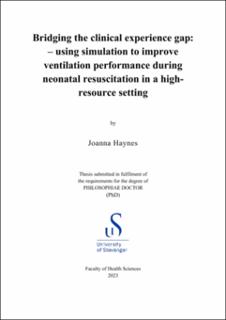Bridging the clinical experience gap: –using simulation to improve ventilation performance during neonatal resuscitation in a high-resource setting
Doctoral thesis
Permanent lenke
https://hdl.handle.net/11250/3094922Utgivelsesdato
2023Metadata
Vis full innførselSamlinger
- PhD theses (HV) [52]
Originalversjon
Bridging the clinical experience gap: –using simulation to improveventilation performance during neonatal resuscitation in a high-resource setting by Joanna Haynes, Stavanger : University of Stavanger, 2023 (PhD thesis UiS, no. 722)Sammendrag
Background: Up to 10% of newborn babies need help to establish regular breathing at birth. Those who do breathe, and who are not fortunate enough to receive prompt and effective help, will die. The burden of neonatal mortality is highest in sub-Saharan Africa and Central-Southern Asia. However, the burden of morbidity in those babies who survive is proportionately a greater problem in middle-income, but also in high-income, countries. Many non-breathing babies respond to stimulation. For those who need more help, positive pressure ventilation of the lungs via a facemask is by far the most important intervention. Training midwives in low-resource settings using simulation training has led to better simulated performance, improved parameters of real-life facemask ventilation, and reduced early neonatal mortality. In high-resource settings like Norway, where paediatricians perform most neonatal facemask ventilation, infrequent simulation training does not replace the lack of clinical experience for midwives and other medical professionals working with women giving birth. It is not known if more frequent simulation training for healthcare providers (HCPs) in a high-resource setting can train and maintain ventilation skills, nor whether it has the potential to change practice in the clinical setting, or impact neonatal outcomes.
Aim: The aim of this thesis was to study methods of using simulation training to bridge the clinical experience gap in ventilation of non-breathing babies at birth in a high-resource setting. The specific aims of the individual papers were to: - 1) determine the realism of simulated ventilation using the high-fidelity manikin NeoNatalie Live; 2) evaluate the effects of a low-dose, high frequency simulation training (LDHFST) programme using NeoNatalie Live on the ventilation competence of multidisciplinary HCPs; and 3) determine the optimal simulation training load to maintain ventilation competence in these HCPs.
Method: A prospective observational study of HCPs from six different professions involved in neonatal resuscitation, with a randomised controlled study arm. Following baseline testing (T1) of simulated ventilation performance, participants attended an educational session, after which their ventilation performance was re-tested (T2). Participants were randomised to one of two training-frequency groups and asked to train independently for nine months, receiving targeted feedback from the simulator to guide their training. These groups were a) intervention group aiming for two training sessions per month and b) control group permitted to choose their own training frequency. After nine months of independent training, participants’ simulated ventilation performance was re-tested a final time (T3). Parallel to the simulation study, all real neonatal ventilation was recorded using a respiratory function monitor (RFM). To evaluate the realism of the simulated ventilation experience (study I, observational), we used panel data regression analysis of RFM data. We compared ventilation data obtained from the manikin when ventilated by paediatricians, with data obtained from real resuscitations performed by the same group of HCPs. The educational benefit of the simulation training programme (study II, randomised controlled study) was assessed by Kruskal-Wallis testing to compare T3 scores for the two training frequency groups. The same test was used to analyse the effect of the ventilation performance test scores, T1, 2 and 3, for the different professions. Finally, we used generalized linear mixed effects models to correlate ventilation competence scores, obtained by participants during their nine months of independent training, with training load (frequency and dose) (study III, observational). Estimated marginal probabilities of successful outcomes identified training loads predictive of high scores.
Results: Study I - We found similarities in three important ventilatory parameters and their inter-relationships, and the same frequency of upper airway obstruction, in the manikin and neonates, supporting the fidelity of the simulated ventilation experience. Study II - 187 HCPs from paediatric, obstetric and anaesthesia services completed the simulation study. Those randomised to the intervention group trained on average 8 sessions in 9 months, while those in the control group trained 2.8 sessions. There was no difference in T3 scores between these two groups. Subgroup analysis comparing T3 scores for those performing no sessions versus those performing 9 or more sessions in 9 months showed a significant difference in favour of training. Paediatricians scored significantly higher at T1 than the other five professions. For the paediatricans, there was no difference in scores at T1, 2 or 3. Overall, scores improved significantly from T1 to T2 and to T3. At T3 there was no difference in the scores for all six professions. Study III - During the 9 months of independent training, 4348 simulation cases were performed. Training on average 0.6 sessions per month was predictive of high ventilation competence scores for all 187 participants.
Conclusion: NeoNatalie Live effectively simulates conditions encountered during real-life neonatal ventilation. Ventilation competence can be trained through simulation, and brief, frequent sessions maintain competence despite a lack of on-going clinical opportunities to practice this skill. For this multidisciplinary group of healthcare providers, training on average once every other month maintains competence.
Består av
Paper 1: Haynes, J., Bjorland, P., Gomo, Ø., Ushakova, A., Rettedal, S., Perlman, J., & Ersdal, H. Novel Neonatal Simulator Provides High-Fidelity Ventilation Training Comparable to Real-Life Newborn Ventilation. Children. 2021; 8(10):940. https://doi.org/10.3390/children8100940Paper 2: Haynes J., Rettedal S., Perlman J., & Ersdal H. A Randomised Controlled Study of Low-Dose High-Frequency In-Situ Simulation Training to Improve Newborn Resuscitation. Children. 2021; 8(12):1115. https://doi.org/10.3390/children8121115
Paper 3: Haynes J., Rettedal S., Ushakova A., Perlman J., & Ersdal H. How much training is enough? Low-dose, high-frequency simulation training and maintenance of competence in neonatal resuscitation. Manuscript submitted to Simulation in Healthcare, under review. Not included in the repository.
Utgiver
University of Stavanger, NorwaySerie
PhD thesis UiS;;722

